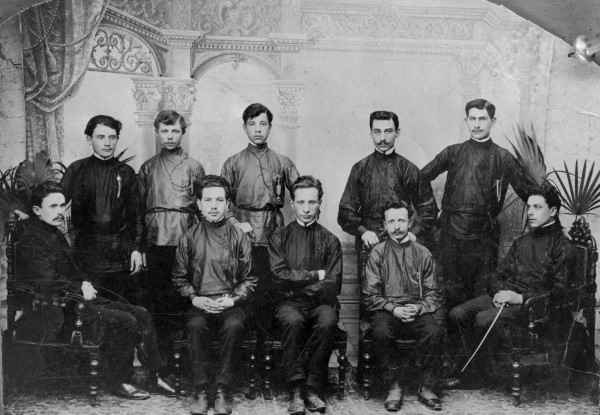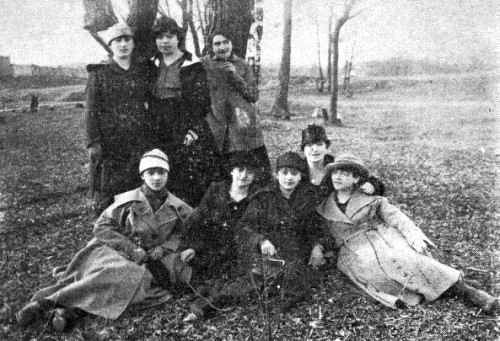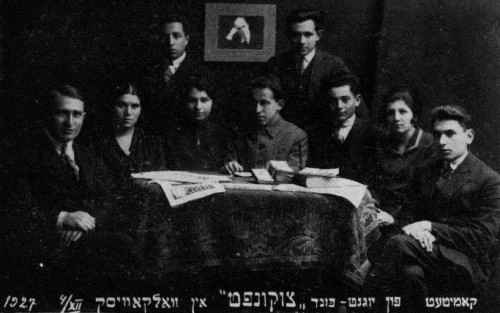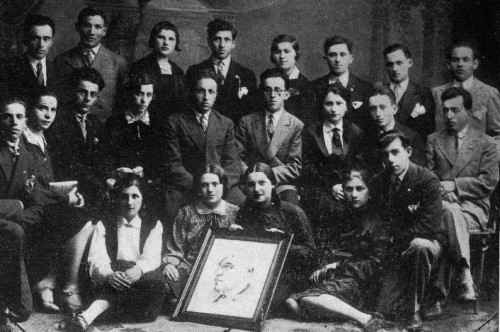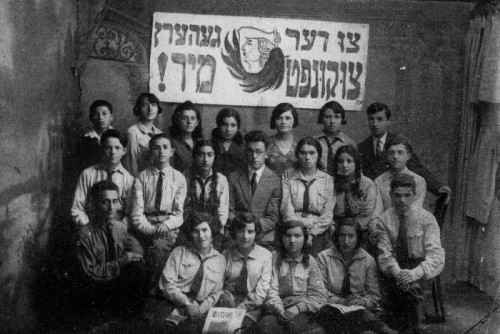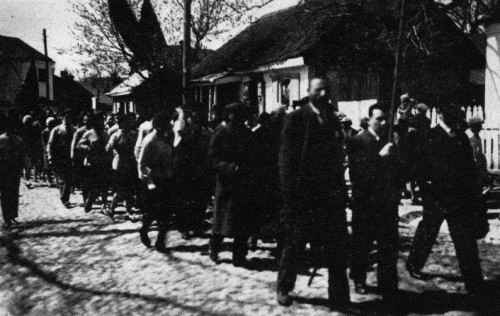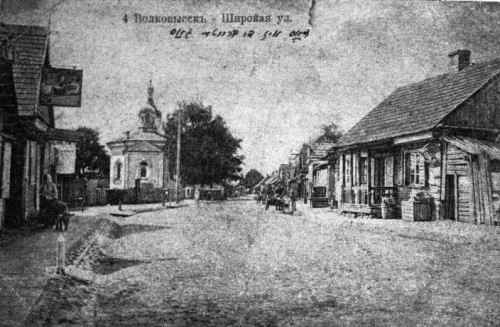[Page 155]
The Volkovysker Bund
Based on the information I received from Beyle Rivka Kushnir–Cohen (Berl Simkhe's daughter),
Heyman Shalkes (Cohen), Moyshke Kasriel's (Zayets), and Shmuel Rotbart (Chudozhnik)
Translated by Baruch Blum
Edited by Yocheved Klausner
|
In Memorium
This is dedicated to my great grandfather, Samuel Rothbort, painter
and son of Vokovysk, and to his fellow members of the Jewish Labor Bund.
May their memory be a blessing
Molly Crabapple |
The Bund played a prominent role in the Vokovysker Jewish society. In the 1939 city council election, the Bund received up to 3,000 votes, and 3 Bundist councilmen were appointed: Sh. Ravitsky, Yitskhok Merkin (the teacher) and L. Shlosberg. The representatives of the Bund in the community were: Sh. Lev, the butcher Shevokhovitsh and Lipshitz. The Bund had its own location and was very active – organized meetings, lessons, evenings, discussions, trips etc.
In the last years before the war, there also existed as part of the Bund the youth movement Tsukunft, the children's organization “Skif”, and the sport union Morgenshtern. They were very active in the cultural and social areas..
The history of the Volkovysker Bund
The history of the Bund in Volkovysk is similar to the history of the Bund in hundreds of cities and towns in Poland and Lithuania. Starting at the beginning of the 20th century as a small “kruzhak” (circle), it became later a powerful organization with a branched out political operation, which left its mark on the Jewish population. Therefore we think it is worthwhile to present a short overview of the founding and development of the Volkovits Bund.
[Page 156]
By the end of the 19th century, there were several hundred Jewish workers; some of them were employed in Yanovsky's tobacco factory, in the beer breweries, in the tannery, and some were apprentices by cobblers, tailors, and other trades. The situation of the tradesmen and workers was a sad one. True, the apprentices could at least be sure of their poor meals, which they received from their masters, but the problem was that their masters would treat them as errand boys. They had to clean the house, help the woman of the house in her domestic work, and do whatever hard tasks before the master craftsman would start teaching them the trade. Also, the apprentices would have to work Saturday nights, right after havdalah. And the worker's situation wasn't much better. He would also have to work long hours every day for meagre pay.
The struggle between the apprentices and the craftsmen
After the start of the Bund – in Vilna in 1897 – the Jewish worker in Volkovysk became more aware. News of worker strikes in the larger cities reached him. In the summer months, students, teachers, and intellectuals come to Volkovysk from Vilna and other cities, who were involved in revolutionary activity, and they begin to awaken class consciousness among the workers.
The first strike in Volkovysk had the slogan:
[Page 157]
|
|
A group of “Bund” activists in 1905
From right to left, first row, sitting: Hershel Zukerman, Zeidl the book–binder, Yosef Kapitan (Likovski), Moshe–Yosl the furrier, Michael Zon–Mazye;
Second row, standing: Moshe Katriel's (Zayetz), Beril Karpowitz, Chaim Shalke (Cohen), Moshe'ke the turner, Israel the locksmith (from the New Alley) |
[Page 158]
“Down with Saturday nights!” However, the craftsmen didn't want to give in and fought against the leaders of the strike. One of the stronger young men in the city helped the craftsmen and beat up the rebels. Such a fight once broke out in the anteroom of the synagogue when they were saying “Nesane Tokef” (said during Rosh Hashana / Yom Kippur). But the young workers prepared themselves and brought help from the surrounding towns and overcame the craftsmen and their strongmen. Some of the “strongmen” then regretted and joined the rebels. In the end, the apprentices won their battle and Saturday night work was cancelled. This victory encouraged the Jewish workers of Volkovysk, and they started organizing on a larger scale. It happened to be that at that time, a student from Vilna, Chaim Nemzer, who had not been able to do his studies in the university in Vilna due to the Czar's decrees, came to town. He became a Russian teacher in Volkovysk. He devoted himself to organizing the Jewish workers and became the leader of the Volkovysk “Kruzhak” (circle)
Beginning of the “Kruzhak”
The “kruzhak” took as its goal the organization of the workers –– both for those who worked by various craftsmen, as well as those who worked in the few factories which were at that point in the city –– and to educate the workers to be aware and fight for better living conditions for themselves and for a better future for all mankind.
The founders of the kruzhak strived not only to improve the material conditions of the workers, but also to bring the workers to a higher level of consciousness and spread education and awareness among them. For that reason, they established a library in which there were various literary works as well as popular scientific and political books and brochures – legal and illegal. At that time, at the beginning
[Page 159]
|
|
A group of women, members of the “Bund” in 1917
Right to left, first row: Maite Pekarski, Ronia Ponar, Gitel Bayer, Chamke Lew, Lea'ke Ravitz;
Standing: Peshe Kaplan (David Hirshel's), Itke from Porzeve, Rose Lewitt. |
of the 20th century, the library was a good method to attract candidates for the workers' movement. Those in charge of the library would initially give readers works of general interest –– novels and stories of Jules Verne, Tenenboym and others –– and later, after having gradually gotten to know the character and intellectual level of the reader, they would start giving them more serious books of a socialist and revolutionary character, as well as illegal brochures which the Bund published. After having assured that the reader was a knowledgeable and trustworthy person, they took him into the kruzhak and invited him to the secret evenings, meetings and May 1st gatherings, which the kruzhak would arrange – summer in the forest and winter in certain homes. During these gatherings, there were also sung “Di shvue” (the oath) and other various revolutionary and folk songs, and the then particularly popular songs: “Dorten in vinkl, in nasen keler” (there in the corner, in the wet cellar), and “Der gezaltsener yam fun mentshlikhe trern” (the salty sea of human tears).
[Page 160]
The activists of the Kruzhak
The management committee of the Volkovysk kruzhak was made up of 7 to 11 people, and every one of them had under his watch 10 members of the kruzhak which he had to watch over and educate politically and socially.
The first founders of the Bund–kruzhak were Yudl Likovsky and his brother Yosef (Kapitan), Moyshke Zakroy (Feyvl the shoykhet's son), Beyle Rivke (Berl Simkhe's daughter), Berl Karpovitsh, Yankl Levin (son of Tsipe di zise, (“the sweet”) and Roze Aynhorn.
At the very beginning, the management was made up of 8 people and the kruzhak had 30 members. Later the kruzhak grew to about 70 –80 members. Among its active members were: Chaim Nemzer, Moyshe Kasriels (Zayets), Chaim Shalkes (Heyman Cohen), Moyshe the turner, Yisroelke the locksmith, Hershl Zuckerman, Zeydl the book–binder, Moyshe Yosel the furrier, Mikhoel Zon–Mazye, Motl Khane Soshes, Yosel (Popiyol's son), Velvl the baker, Yedidye the baker, Yankl the carpenter, Sime Khaykls, Moyshe Nakhes (Lapin the Ekspediters son), Dovid Bogomilsky (Kasriel the baker's son), Shmuel Chudozhnik, Bodany (the tinsmith's daughter), Khayke dem Shleyfers, Dvoshke, Bobele Odef (Leyzer Chaim's daughter), Perl Lev (The Bialystoker baker's daughter), Avreyml Odef (Leyzer Chaim's son), Sholem Barashie's son, Hershele (Bontshe the cobbler's son), Litmon (Mendl the baker's son), Hershl Rokhkin, the young L. Shlosberg (of the brickyard), Yankl der shvartser [the black], Khono Glok, Mendl Nisn (the shoykhet's son), Dovid Eynhorn, Zeydl Faynzilber, Golde Papes, Keyle (Dovid Hershl's daughter), Khasye Salman, Beylke the Chasid's, Yedidye Margolis, Moyshe Tshoper, Berl Dzhik, Itshe Niezhik, Yankl Lifshitz, and others.
These members would from time to time gather in various houses and have their meetings there. Among the gathering places were: the Likofskys' (Khane Fride's sons, who lived on the “wide street” (Breyte Gas), Beyle Rivke (Berl Simkhe's daughter), the teacher Berl Karpovitsh (who lived by Berl
[Page 161]
|
|
The Committee of “Zukunft” [Future] the Youth–Bund organization in Volkovisk, 4.12.1927
Right to left, sitting: The Zabeliner, Rose Vloski, Yudel Stolovitzki, Yankel Rubinstein (the locksmith's), Reizl, Chana Irmes,Shimon Lew (Yehuda Hirsh the butcher's);
Standing: Chone Falkowitz (the tailor), Shmuel Pashinker |
Kushnir in Slutsky's alley), and also at times in the “Tiferes Bakhurim” synagogue. These secret meetings were known as the “Skhodkes”.
In the summertime, the secret meetings would take place in the Samkow forest, and at times, on the “Mayok”. The gatherings were always watched over by a group of members who were familiar with all the paths and ways of the neighborhood, in order to avoid the notice of strangers. In case of an informer, they were always ready to slip out of the police's hands. The gatherings usually took place in the afternoons of the Sabbaths and holidays. In the forest on the grass one could often hear fiery and enlightened speeches about strikes, self–defense, and general Bund activities.
[Page 162]
|
|
The Michailevitch group of “Zukunft” the Young Bund
Sitting right to left: Yankel Lew, Yankel Pereminski, Miss Pereminski, Yankel Rubinstein (the locksmith), Yankel Pashinker, Miss Rubinstein, Yudel Zlotnitzki, Mrs. Pashinker, Bayer |
Among the things discussed at the gatherings were plans to attack government convoys and government alcohol monopolies and expropriate money, in order to have tools to lead the revolutionary work. Such an attack was once in Izabelin. They cut the phone lines and accomplished the expropriation.
Berl Dzhukin was once arrested, for political activity. So the Kruzhak [circle] members sawed the iron bars and took him out of the jail and hid him in Beyle Rivke's house. The government searched many suspected houses. Karayev, the well–known policeman, accompanied by Gendarmes, searched Beyle Rivke's house, but Berl, disguised as an old Jewish woman, escaped through another door and disappeared.
They also used to attack the convoys
[Page 163]
|
|
Members of the Bund Youth Organization
In the photo is Yankel Rubinstein, the leader of the Bund
The caption in the photo: “We belong to Zukunft” [the future] |
that drove arrested revolutionaries –– they threw tobacco in their faces and freed those arrested.
In October 1905 –– when all of Russia was in a revolutionary fever and they celebrated October 17th –– the Volkovysker Bundists also planned to organize on that day a big demonstration. It happened to be that at that time a prominent member of the Kruzhak, Yosl Kishke, died. The kruzhak decided to turn his funeral into a demonstration. Beyle Rivke (Berl Kushnir's daughter) made a black flag and a red flag. Yudl Likovsky gave a fiery eulogy. All the stores were closed, and masses of people took part in the funeral. For a long time it was remembered by the Volkovysk residents.
[Page 164]
|
|
| Demonstration on May 1st with the participation of the Bund |
The representative from the central committee of the Bund, Vladek “The young Lasalle”, visited Volkovysk, and this pushed significantly forward the development of the Volkovysk Bund. His lecture in Polakov–Lev's beys–medresh (study hall) made a big impression.
The Bund before the Second World War
Years went by. In Volkovysk a slaughterhouse and a meat preserve factory were established. Then there came houses, buildings, mills, brickyards, workshops, sawmills; the number of Jewish workers grew, and with them the Bund also grew.
Among the activists in the Bund in the last years prior to the second World War were: Yankl Rubinshteyn (Yudl the locksmith's son), Shmuel Pashinker, Avrohom Markus, M. Zeliviansky, Berl Palkovitsh, Shimon Lev (Yehuda the butcher's son), Yankl Lev, Yitskhok Merkin, L. Shlosberg, Sh. Ravitsky,
[Page 165]
|
|
| “Di Breite Gas” [the Wide Street] (near the church) |
Khono Palkovitsh, the Zabeliner, Roze Vlosky, Yudl Stolovitsky, Khane Irmes, Abo Shtumer, and Yankl Pereminsky.
As mentioned, the Volkovysk Bund was very active between the two wars. It often brought speakers from Vilna and Warsaw, and celebrated the workers' holidays and Bund anniversaries. Regional gatherings of the Bund were occasionally held in Volkovysk. There was much activity in the Volkovysker Bund, and they often had concerts, readings, evenings, and activities –– until it was destroyed along with the rest of the Volkovysk Jewish population.
This material is made available by JewishGen, Inc.
and the Yizkor Book Project for the purpose of
fulfilling our
mission of disseminating information about the Holocaust and
destroyed Jewish communities.
This material may not be copied,
sold or bartered without JewishGen, Inc.'s permission. Rights may be
reserved by the copyright holder.
JewishGen, Inc. makes no representations regarding the accuracy of
the translation. The reader may wish to refer to the original material
for verification.
JewishGen is not responsible for inaccuracies or omissions in the original work and cannot rewrite or edit the text to correct inaccuracies and/or omissions.
Our mission is to produce a translation of the original work and we cannot verify the accuracy of statements or alter facts cited.
 Vawkavysk, Belarus
Vawkavysk, Belarus
 Yizkor Book Project
Yizkor Book Project
 JewishGen Home Page
JewishGen Home Page
Yizkor Book Director, Lance Ackerfeld
This web page created by Jason Hallgarten
Copyright © 1999-2026 by JewishGen, Inc.
Updated 16 Dec 2019 by MGH
